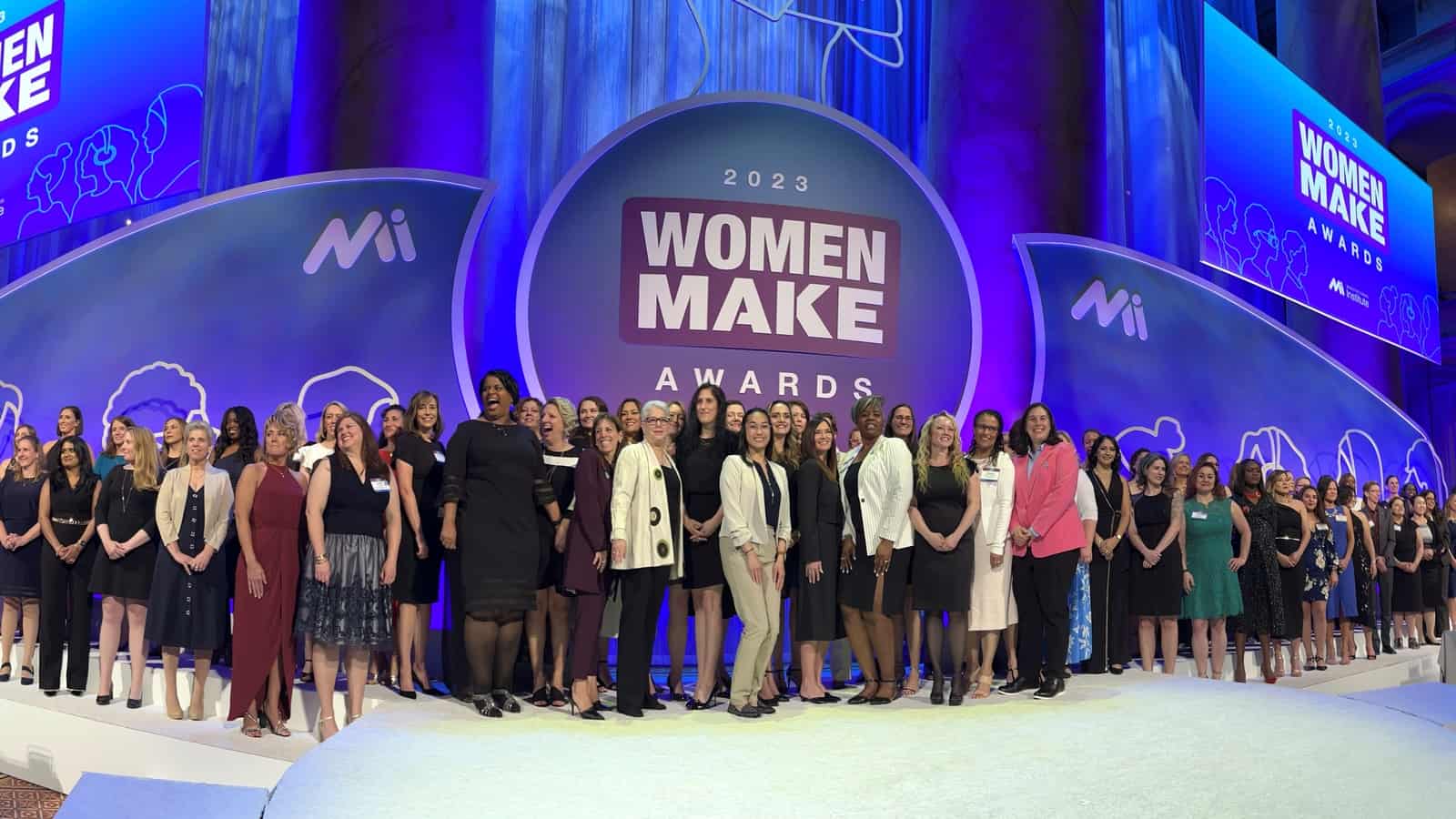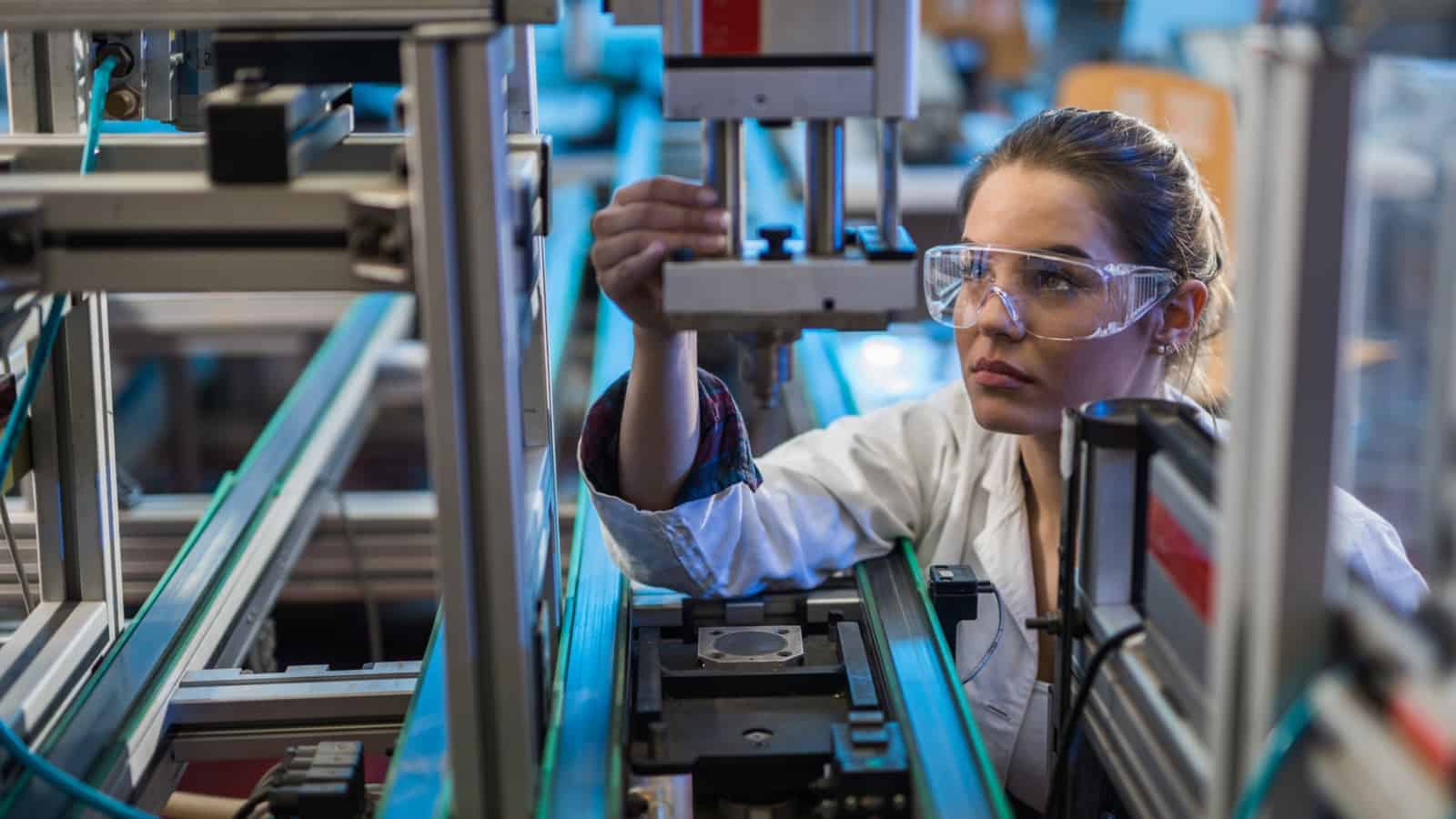Army, Navy, Air Force, and Marines! Heroes MAKE America is Reaching More Veterans

When service members leave the military, manufacturers are quick to say: “Come on over!” Military skills are usually a great match for manufacturing careers, which require attention to detail, technical abilities and creative thinking. And there’s no better matchmaker than the Manufacturing Institute’s Heroes MAKE America initiative, which since 2018 has been offering training certification programs and career courses to transitioning service members and veterans.
Today, HMA not only serves service members on military installations across the country but has also expanded its reach via a virtual training program.
Widening the reach: Now in its second year, the virtual training program has allowed HMA to impact service members on a national scale.
- For the first time, members from four branches—Army, Air Force, Marine Corps and Navy—are participating in the same class at the same time.
- Additionally, the geographic range of participants has increased to comprise students located far and wide, including in Alaska, Arizona, Delaware, Kansas and Kentucky.
- The program has reached more than 120,000 prospective students through local transition assistance, HMA’s LinkedIn and Facebook presence and the SkillBridge website.
How it works: HMA partnered with Texas State Technical College to create a virtual nine-week training and certification program.
- Participants earn nationally portable, industry-recognized Certified Production Technician certification as well as an OSHA 10 certification.
- Through Heroes Connect, HMA also partners with sponsors like Johnson & Johnson, The Caterpillar Foundation, Amazon, Howmet Aerospace, WestRock, Saint-Gobain, Atlas Copco, Cargill, FUCHS Lubricants Company, C.H. Guenther & Sons, Honda Foundation, Niagara Bottling and the NAFEM, PPI and SEMI Associations to connect program graduates and members of the military community with manufacturers.
What we’re saying: “It’s exciting to see members from four branches of the military all in one virtual classroom together,” said Heroes MAKE America Senior Program Manager Katie Bowerman. “There’s a lot of strength in that kind of diversity.”
Spread the word: Do you have jobs for which HMA students might qualify, or know of a service member who would want to join the program? The HMA virtual program is open to any transitioning service member who is in their last six months of active-duty service, as well as to veteran and active-duty military spouses. For more information, contact [email protected].
Army, Navy, Air Force and Marines! Heroes MAKE America is Reaching More Veterans

When service members leave the military, manufacturers are quick to say: “Come on over!” Military skills are usually a great match for manufacturing careers, which require attention to detail, technical abilities and creative thinking. And there’s no better matchmaker than the Manufacturing Institute’s Heroes MAKE America initiative, which since 2018 has been offering training certification programs and career courses to transitioning service members and veterans.
Today, HMA not only serves service members on military installations across the country but also has expanded its reach via a virtual training program.
Widening the reach: Now in its second year, the virtual training program has allowed HMA to impact service members on a national scale.
- For the first time, members from four branches—Army, Air Force, Marine Corps and Navy—are participating in the same class at the same time.
- Additionally, the geographic range of participants has increased to comprise students located far and wide, including in Alaska, Arizona, Delaware, Kansas and Kentucky.
- The program has reached more than 120,000 prospective students through local transition assistance, HMA’s LinkedIn and Facebook presence and the SkillBridge website.
How it works: HMA partnered with Texas State Technical College to create a virtual nine-week training and certification program.
- Participants earn nationally portable, industry-recognized Certified Production Technician certification as well as an OSHA 10 certification.
- Through Heroes Connect, HMA also partners with sponsors like Johnson & Johnson, The Caterpillar Foundation, Amazon, Howmet Aerospace, WestRock, Saint-Gobain, Atlas Copco, Cargill, FUCHS Lubricants Company, C.H. Guenther & Sons, Honda Foundation, Niagara Bottling and the NAFEM, PPI and SEMI associations to connect program graduates and members of the military community with manufacturers.
Read the full story here.
China Seeks Non-Western Lithium Sources

China, which already commands most of the world’s lithium refining, is undertaking “a risky strategy” in an effort to lay claim to more of the metal globally: buying stakes in mines located in developing nations, according to The Wall Street Journal (subscription).
What’s going on: “China is spending billions on stakes in nations that have histories of political instability, local resistance and resource nationalism. Projects often face protests, regulatory delays and even cancellations. If China succeeds, however, it could secure access to one-third of the world’s lithium-mine production capacity needed by 2025, according to industry estimates.”
- Canada and Australia, which hold among the world’s largest lithium reserves, recently put an end to new Chinese investments in critical minerals.
Why it’s important: Lithium is a critical component of batteries used in electric vehicles and smartphones—and demand for the mineral could outstrip supply significantly by the end of the decade.
A precarious investment: To ensure sufficient lithium stock to power its EV industry (particularly as tensions with the U.S. rise), China has acquired stakes in close to 20 mines throughout Latin America and Africa.
- Some of the countries in which the mines sit face the risk of terrorist attacks, while others have a history of revoking agreements made with foreign firms.
However … China has some advantages over Western nations when it comes to securing lithium from South American and African nations.
- “CATL, for example, is a battery behemoth, with the political backing of Beijing and a strong network of companies along the supply chain.
- Developing nations often want to partner with Chinese firms that also do processing, refining or battery making, because they believe such companies will better guarantee them steady streams of income.
China Leads in EVs

Why is China winning the electric-vehicle production race? Because it controls or dominates every step of the process of making EV batteries, according to The New York Times (subscription).
What’s going on: “Despite billions in Western investment, China is so far ahead—mining rare minerals, training engineers and building huge factories—that the rest of the world may take decades to catch up.”
- Rare minerals: China owns the majority of the cobalt mines in Congo—where most of the world’s supply of the metal sits—and it controls most of the world’s lithium mining.
- Refining: “Regardless of who mines the minerals, nearly everything is shipped to China to be refined into battery-grade materials.”
- Components: China produces more EV batteries than any other country, which it managed “partly by figuring out how to make battery components efficiently and at lower cost.”
- Final products: China boasts the most EVs on the road of any nation, and almost all of them use batteries made domestically.
Why it’s important: Now, eight years after the Chinese government instituted policies to bar foreign competitors from the EV market and increase consumer demand, “the Biden administration … [is] pursuing a similar strategy to foster battery development in the United States. But in a business with huge capital costs and thin profit margins, Chinese companies have a big head start after years of state funding and experience.”
G7 Not “Decoupling” From China

G7 leaders are focusing on “de-risking,” but not “decoupling” from China, they said in a joint statement covered by CNBC.
The details: “We are not decoupling or turning inwards,” the statement said. However, “we recognize that economic resilience requires de-risking and diversifying.”
- “We will seek to address the challenges posed by China’s non-market policies and practices, which distort the global economy,” the leaders continued. “We will counter malign practices, such as illegitimate technology transfer or data disclosure.”
Biden concurs: President Biden echoed these sentiments at a press conference on Sunday, emphasizing the need to “diversify” supply chains so that no one country has a monopoly on any essential product.
- “It means resisting economic coercion together and countering harmful practices that hurt our workers,” he continued. “It means protecting a narrow set of advanced technologies critical for our national security.”
In sum: “We stand prepared to build constructive and stable relations with China, recognizing the importance of engaging candidly with and expressing our concerns directly to China. We act in our national interest,” the G7 statement said.
NAM in action: As exemplified by its recent Competing to Win Tour in Europe, the NAM is working to bring business and government leaders together to strengthen the resilience of manufacturers in the United States and our democratic allies in the face of greater uncertainty with respect to China.
The last word: “Manufacturers have consistently called for a rethink of the U.S.–China relationship to boost competitiveness globally,” says NAM Vice President of International Economic Affairs Ken Monahan.
- “The strategy requires collaborating with allies for supply chain resilience, addressing discriminatory Chinese policies and creating trade openings through robust agreements. Yesterday’s announcement highlights the path ahead.”
Women MAKE Awards Showcase Manufacturing Excellence

The energy and enthusiasm of the night were fittingly high for the occasion: a gala to honor 130 standout women in manufacturing.
What went on: The Manufacturing Institute’s 2023 Women MAKE Awards—formerly the STEP Ahead Awards—took place Thursday evening at the National Building Museum in Washington, D.C., following the two-day Women MAKE Leadership Conference. (The MI is the NAM’s 501(c)3 workforce development and education affiliate.)
- The gala—which featured a live performance by violinist Ezinma and was sponsored this year by BASF, Trane Technologies, Amazon and others—is held each year to honor women in manufacturing who exemplify leadership in their careers.
- This year the awards recognized 100 honorees and 30 “emerging leaders,” women under the age of 30 who have achieved unique accomplishments.
What was said: MI President and Executive Director Carolyn Lee delivered the night’s opening remarks, telling audience members she was humbled to be in their midst.
- “We have women who have launched entire product lines,” she said. “Women with dozens of patents to their name. Women who oversee the production and distribution of millions of products every day … women who constantly exceed expectations.”
- Carolyn Lee touched on the MI’s year-old 35×30 campaign, which aims to raise the percentage of women in manufacturing from 29% to 35% by 2030, and said the women honored at the gala serve as inspiration to young women considering manufacturing careers. “Because if you can see it, you can be it,” she said.
“The opportunity”: WMA Chair and Cornerstone Building Brands President and CEO Rose Lee underscored the importance of filling the current shortfall of manufacturing workers.
- If the shortage continues unchecked, the number of missing workers could exceed 2 million by 2030, she said, citing a study by the MI and Deloitte.
- “Therein lies the opportunity to engage an untapped, underutilized pool of women talent in the vitally important manufacturing sector,” Lee continued. “This is the collective work we need to pursue, and the honorees and emerging leaders here tonight are advancing this work by demonstrating the myriad ways in which women can achieve professional success in the manufacturing industry.”
Thank you: MI Board Chair and NAM President and CEO Jay Timmons thanked the honorees for showing the next generation what’s possible.
- “Thank you for being role models—including for my daughters and my son, the many families we have in this room and the people you impact every day,” Timmons said. “The ripple effect you can have is incalculable.”
From one to many: Rounding out the night’s lineup was event Vice Chair and Caterpillar Inc. Group President of Resource Industries Denise Johnson, who told the audience it was “remarkable” to be in a room with so many other women in manufacturing.
- “There have been many times throughout my career when I’ve been the only woman in a room, the only woman on a project,” she said. “What an incredible change of pace this is. I … am overwhelmed with gratitude and pride for how far we’ve come. Congratulations to all of you.”
Announcing the 2023 Manufacturing Leadership Award Finalists!

The Manufacturing Leadership Council—the NAM’s digital transformation division—has announced the finalists for the 2023 Manufacturing Leadership Awards, the industry’s premier awards program for achievements in digital manufacturing. You can read the complete list of finalists here.
The ceremony: The finalists will be honored at the Manufacturing Leadership Awards Gala in Marco Island, Florida, on June 28.
- Also announced at the gala will be winners for all project and individual categories, winners of the Manufacturing in 2030 Award, the Manufacturing Leader of the Year, the Small/Medium Enterprise Manufacturer of the Year and the Large Enterprise Manufacturer of the Year.
Rethink: Certain award winners will also present at Rethink, the industry’s leading event for exploring manufacturing’s digital era, which will also take place in Marco Island on June 26–28.
The categories: The awards are divided into nine project categories to recognize company achievements:
- Artificial Intelligence and Machine Learning
- Collaborative Ecosystems
- Digital Network Connectivity
- Digital Supply Chains
- Engineering and Production Technology
- Enterprise Technology Integration
- Operational Excellence
- Sustainability and the Circular Economy
- Transformational Business Cultures
Additionally, individual leaders are recognized in the Digital Transformation Leadership and Next-Generation Leadership categories.
The last word: “As more manufacturers extend digital’s reach onto the factory floor and throughout their operations, we are witnessing transformative performance improvements that would have been unthinkable just a few short years ago—and that are improving life for employees and customers alike,” said MLC Co-Founder, Vice President and Executive Director David R. Brousell.
Senators Reintroduce Crucial R&D Bill

A bipartisan Senate duo introduced legislation on Thursday that would both allow businesses to once again fully deduct R&D expenses in the year they are made and expand the refundable R&D tax credit.
What’s going on: The American Innovation and Jobs Act, sponsored by Sens. Maggie Hassan (D-NH) and Todd Young (R-IN), would restore the immediate deductibility of R&D expenses. Last year, a tax change went into effect requiring companies to amortize or deduct their R&D investments over a period of years, making R&D more costly.
Why it’s important: According to a recent NAM analysis, the sector would lose nearly 60,000 jobs and face an output decline of more than $31 billion this year alone if the change is not reversed.
- The U.S. has now become a global outlier, joining Belgium as the only other developed country requiring the amortization of R&D expenses.
- Meanwhile, China provides a 200% “super deduction”—20 times the amount allowed in the U.S. tax code—for its manufacturers’ research.
The NAM says: “Manufacturers applaud the introduction of the American Innovation and Jobs Act, which will help the U.S. out-compete China,” said NAM Managing Vice President of Tax and Domestic Economic Policy Chris Netram.
- “Across the country, manufacturers are hiring workers, investing in communities and creating the products, materials and processes that drive us forward. Congress should approve the American Innovation and Jobs Act quickly to support critical research that allows manufacturers to improve lives in America and for people around the world.”
Learn more: Read our stories on how the 2022 expensing requirement is impacting International Paper, Marlin Steel Wire Products, Ultragenyx, Miltec UV and Brewer Science (whose story was also covered today by The Wall Street Journal, subscription).
Sens. Hassan and Young Reintroduce Crucial R&D Legislation
American Innovation and Jobs Act will ensure that the tax code supports the ability of manufacturers to out-compete China and create well-paying jobs
Washington, D.C. – Following the introduction of the American Innovation and Jobs Act by Sens. Maggie Hassan (D-NH) and Todd Young (R-IN), National Association of Manufacturers Managing Vice President of Tax and Domestic Economic Policy Chris Netram released the following statement:
“Manufacturers are hiring workers, investing in communities across the United States and creating the products, materials and processes that drive America forward. Manufacturers applaud the introduction of the bipartisan American Innovation and Jobs Act, which restores full deductions for research, helping the American industry out-compete China, which provides a 200% super deduction for manufacturers’ research—20 times the amount in the U.S. tax code,” said Netram. “Manufacturers, the vast majority of which are quite small, perform 55% of private-sector research and development. These investments in innovation spur economic growth and support the creation of high-paying jobs across the country. Congress should approve the American Innovation and Jobs Act quickly to support critical research that allows manufacturers to improve lives in America and for people around the world.”
Background: As of 2022, manufacturers can no longer immediately deduct their R&D expenses in the year in which they are incurred. Instead, manufacturers must deduct or amortize their expenses over a number of years, which makes R&D much more expensive to undertake. The American Innovation and Jobs Act would restore the immediate deductibility of R&D expenses, a policy that was in place for nearly 70 years. In the 117th Congress, the American Innovation and Jobs Act garnered 35 cosponsors: 17 Democrats and 18 Republicans. A recent analysis released by the NAM finds that the industry would lose 59,392 jobs and face a decline in output of $31.69 billion this year if Congress does not act.
-NAM-
The National Association of Manufacturers is the largest manufacturing association in the United States, representing small and large manufacturers in every industrial sector and in all 50 states. Manufacturing employs nearly 13 million men and women, contributes $2.81 trillion to the U.S. economy annually and accounts for 55% of private-sector research and development. The NAM is the powerful voice of the manufacturing community and the leading advocate for a policy agenda that helps manufacturers compete in the global economy and create jobs across the United States. For more information about the NAM or to follow us on Twitter and Facebook, please visit www.nam.org.
Professional Development Resource: Building Your Personal Brand
On February 16, the Manufacturing Institute held a professional development virtual event on building your personal brand, presented by branding expert Cat O’Shaughnessy Coffrin, Founder and CEO of CaptivatingCo.
View the recording here and the slide deck here.
TOPLINE TAKEAWAYS
Your personal brand consists of:
- Proposition: The value you create
- Persona: Your X factor
- Purpose: What drives you
Steps you can take to start building your personal brand:
- Self-Reflect: What role do you play on your team? What skills do you bring? Look for patterns in your career on how you approach your job and get things done.
- Ask For Feedback: Connect with your colleagues and friends and ask how they would describe the attributes, attitudes and skills you bring to the table. This external perspective is valuable for shaping your narrative.
- Connect and Reconnect: Remember that teacher who had a profound impact on you? Or a former colleague who you lost touch with? Reach out to them and schedule a coffee to catch up and remind yourself how many people are in your corner wanting you to succeed.
- Revisit Your LinkedIn: There are two simple step you can take right now to enhance your online presence; make sure your ‘About’ section is drafted in the first person (LinkedIn is a social platform!) and identify, follow and engage with leaders of topics that interest you.